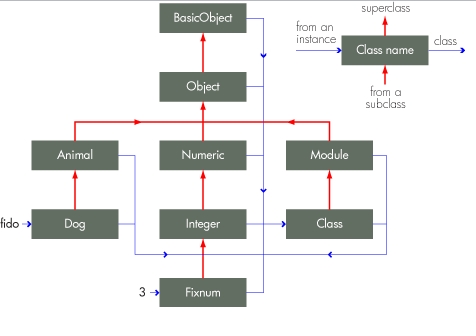CSC/ECE 517 Fall 2012/ch1 1w17 ir
Extending Objects
The ‘extend’ feature in computer programming languages allow the programmer to dynamically extend the functionality of an object at runtime, as opposed to extending functionality at compile time. This feature can be found in Object Oriented Programming (OOP) Languages.
Introduction
The programming paradigm OOP uses 'objects' for designing applications. These objects consist of an encapsulated set of data fields and methods, and are usually an instance of a class. These objects can communicate with each other through messages (or 'methods') and process data in object oriented programming. But in order to increase an object's functionality, it is necessary to add the features of one object to another. This can be done dynamically at run time, without repeating the code, by extending the features of one class to another. This can be done by the use of the 'extend' keyword. Many OOP oriented languages support the 'extend' feature.
An object is an entity that serves as a container for data and also controls access to the data. Associated with an object is a set of attributes, which are essentially no more than variables belonging to that object. Also associated with an object is a set of functions that provide an interface to the functionality of the object, called methods. - Hal Fulton[2]
Languages Using 'extend' Functionality
C++
Object-oriented programming features like abstraction, encapsulation, inheritance, and polymorphism were added in C and introduced as C++. In C++, the data and functions are bundled together as a self-contained unit called an object[3]. In C programming language, the class describes only the data properties. Similar to the structures found in C, a class in C++ describes both the properties (data) and behaviors (functions) of objects. Classes are not objects, but they are used to instantiate objects.
Example Code Snippet
Java
Object Oriented Programming or OOP is the technique to create programs based on the real world. Unlike procedural programming, here in the OOP programming model programs are organized around objects and data rather than actions and logic. Objects represent some concepts or things and like any other objects in the real Objects in programming language have certain behavior, properties, type, and identity. In OOP based language the principal aim is to find out the objects to manipulate and their relation between each other. OOP offers greater flexibility and compatibility and is popular in developing larger application. Another important work in OOP is to classify objects into different types according to their properties and behavior.[4]
Objects in Java
Objects are the basic unit of object orientation with behavior, identity. Objects are part of a class but are not the same. An object is expressed by the variable and methods within the objects. Again these variables and methods are distinguished from each other as instant variables, instant methods and class variable and class methods.
Creating Objects
Extending Objects
Example Code Snippet
Javascript
Objects in Javascript
Creating Objects
Extending Objects
Example Code Snippet
Ruby
Ruby is a OOP language. It differs from the previous two OOP languages mentioned above in how it interprets what 'object-oriented' means and the different terminologies for the concepts it employs.
In Ruby, everything is an object and all objects are instances of a class. Even classes are instances of class objects. So when there is a class, .new is called to get an instance of the class and when there is an instance, .class is called to obtain its class [5]. So each class has a superclass and if it doesn't specify any class from which it inherits, then it inherits directly from the Object class.
The picture below depicts the linking between all classes in Ruby. Ruby contains several classes and modules that are available by default. Some of these are Array, Class, Exception, Fixnum, Integer, Numeric, Object, Float, Range, Time, BasicObject, Module and some built-in modules are Kernel, Math, Comparable, Enumerable and so on. All classes are derived from the BasicObject class in Ruby 1.9+. By inheritance rules, all of its methods are available to all the objects.

Another way for an object to gain additional methods is by making use of the 'extend' keyword. By using 'extend' with an object, the object gains the methods from a module it is extending.
Example Code Snippet
Here is an example that shows how Object.extend(module) adds the methods defined in a module at the object's level.
module RubyExample
def helloWorld
"Hello user! Welcome to Ruby!"
end
end
Now, we can extend this module's functionality (i.e, the Greet method) to any object we instantiate. Below we can see that the module's methods have been mixed in to the object.
obj = Object.new obj.extend(RubyExample) obj.helloWorld #=> "Hello user! Welcome to Ruby!"
As mentioned earlier, everything in Ruby is an object. The following confirms this fact:
>> RubyExample.object_id => 45097 >> RubyExample.class => Module >> RubyExample.respond_to?(:extend) => true
Now this is not the only way to extend object functionality in Ruby. We can also do the same thing by
RubyExample = Module.new do
def helloWorld
"Hello user! Welcome to Ruby!"
end
end
RubyExample.extend(RubyExample)
RubyExample.helloWorld #=> "Hello user! Welcome to Ruby!"
So, the above alternative method clarifies the fact that RubyWorld is just an instance of the class Module. We can also do the same thing by including the extend() call within the module definition.
module RubyExample
extend RubyExample
def helloWorld
"Hello user! Welcome to Ruby!"
end
end
RubyExample.helloWorld #=> "Hello user! Welcome to Ruby!"
In Ruby, the keyword 'self' refers to the current or default object itself. So another way of implementing the above is as follows
module RubyExample
extend self
def helloWorld
"Hello user! Welcome to Ruby!"
end
end
RubyExample.helloWorld #=> "Hello user! Welcome to Ruby!"
Another way to mix Ruby modules into a class is by using the 'include' keyword. For more information, see Extend through Include.
Advantages
Disadvantages
Conclusion
See also
References
<references/>